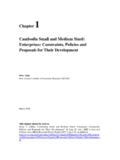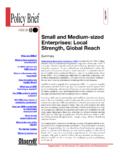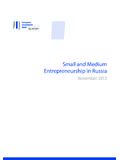Transcription of HUMAN RESOURCE MANAGEMENT PROBLEMS OVER THE …
1 HUMAN RESOURCE MANAGEMENT . PROBLEMS OVER THE LIFE CYCLE OF. small TO medium - sized FIRMS. Matthew W. Rutherford, Paul F. Buller, and Patrick R. McMullen This study uses a sample of 2,903 small to medium - sized firms to examine the manner in which HR PROBLEMS vary over the organizational life cycle. We found that a four-stage model was appropriate. Interestingly, firm age did not emerge as a significant indicator of stage the firms' HR PROBLEMS varied across stages defined by growth. Training PROBLEMS were highest in high-growth firms and lowest in low-growth firms; compensation PROBLEMS were highest in moderate-growth firms and lowest in high-growth firms; and recruiting PROBLEMS were high- est in no-growth firms and lowest in low-growth firms. 2004 Wiley Periodicals, Inc. Introduction MANAGEMENT , and regulation. It is the gen- eral people or HUMAN RESOURCE (HR). It is widely held that new ventures experi- PROBLEMS facing firms in various stages that ence different kinds of PROBLEMS as they grow we intend to examine.
2 However, the specific and mature. This so-called life cycle or stage types of people PROBLEMS or issues are not model of organizational growth has received well defined or well documented in previous considerable empirical support (Dodge & research. This article adds to the literature by Robbins, 1992; Hanks & Chandler, 1994; examining specific HR PROBLEMS across the Kazanjian, 1988; Kazanjian & Drazin, 1989). life cycle of small and medium - sized enter- Most previous studies of the life-cycle model prises (SMEs). have identified or examined different types of Another important feature of this work PROBLEMS based on the size, age, and/or is based on the fact that we address a pri- growth rate of the firm. Examples of these mary weakness of other life-cycle studies. PROBLEMS include the following: strategic po- Researchers often decide upon a number of sitioning, sales/marketing, product develop- stages and then force firms into a prede- ment, production, accounting/financial man- termined stage.
3 The problem with this is agement, external relations, people/ HUMAN that there has been no agreement upon the RESOURCE MANAGEMENT , organization, general correct number of stages in a life-cycle Correspondence to: Matthew W. Rutherford, The Hogan Entrepreneurial Leadership Program, Gonzaga Uni- versity, Spokane, WA 99258, 509-323-3406, HUMAN RESOURCE MANAGEMENT , Winter 2003, Vol. 42, No. 4, Pp. 321 335. 2004 Wiley Periodicals, Inc. Published online in Wiley InterScience ( ). DOI: 322 HUMAN RESOURCE MANAGEMENT , Winter 2003. model models range anywhere from three are unique PROBLEMS (content factors) asso- to ten stages depending upon the study ciated with various stages. (Stubbart & Smalley, 1999). We will over- For example, Kazanjian's (1988) study come this problem by using a novel, power- based on four life-cycle stages in technology ful exploratory classification analysis called new ventures conception and development, There is no a self-organizing map (SOM).
4 Similar to a commercialization, growth, and stability . clear evidence cluster analysis, the SOM approach will found differences in the types of dominant regarding the group cases together based on their similar- PROBLEMS across these stages. Six general sets number of stages a firm ity to one another. However, when compared of PROBLEMS were identified using a ques- to cluster analysis, the SOM provides a more tionnaire methodology: strategic positioning, rigorous grouping procedure through learn- sales/marketing, people, organizational sys- ing iterations and does not bias the data by tems, production, and external relations. assuming a certain number of groups (Jain, Some PROBLEMS ( , strategic positioning Mao, & Mohiuddin, 1996). and sales/marketing) were found to be domi- First we will examine what we know nant across all stages, while other PROBLEMS about the SME organizational life cycle. We ( , external relations and organization).
5 Will then investigate the limited research ad- were more important in some stages and less dressing the intersection of life-cycle and so in others. People PROBLEMS appeared to be HUMAN RESOURCE PROBLEMS . This will lead to moderately important across all stages. specific propositions, which we will test Using a different research method using the SOM and multivariate analysis of (open-ended classification rather than variance. Finally, we will report results and forced-choice), Terpstra and Olson (1993). provide a discussion for these results. identified ten different types of PROBLEMS . obtaining external financing, internal finan- The SME Organizational Life Cycle cial MANAGEMENT , sales/marketing, product development, production, general manage- Theory and research on the organizational ment, HUMAN RESOURCE MANAGEMENT , eco- life cycle (OLC) and stages of development nomic environment, and regulatory environ- indicates that firms progress through vari- ment over two stages (start-up and growth).
6 Ous stages over time. Life-cycle models typ- Consistent with Kazanjian (1988), some ically reflect a sequential progression PROBLEMS ( , sales/marketing and internal through stages such as birth or start-up, financial MANAGEMENT ) were dominant in growth, maturity, and even decline. There is both stages. Other PROBLEMS ( , obtaining no clear evidence regarding the number of external funding and HUMAN RESOURCE man- stages a firm experiences scholars have agement) were more important in some submitted models varying between three stages than others. Huang and Brown (1999). and ten stages (Churchill & Lewis, 1983; conducted a follow-up to the Terpstra and Dodge & Robbins, 1992; Greiner, 1972; Olson (1993) study using a sample of 973. Kazanjian, 1988; Kazanjian & Drazin, 1989; small Australian firms. Their results gener- Kimberly & Miles, 1980; Miller & Friesen, ally supported the classification framework 1984; Quinn & Cameron, 1983; Scott, put forth by Terpstra and Olson (1993).)
7 1971). The controversy regarding the proper number of stages is made apparent Life-Cycle and HUMAN RESOURCE by examining the overview of OLC studies MANAGEMENT PROBLEMS presented in Table I. There are, however, at least two observ- Several studies have examined HUMAN re- able themes across models. The most com- source MANAGEMENT (HRM) PROBLEMS or ac- mon theme is that, regardless of number, tivities related to the organizational life each stage is determined by the contextual cycle. While the distinction between HRM. factors of age of firm, growth rate, and size. PROBLEMS and activities is not always clear The other common theme is that many of in the literature, we define HRM PROBLEMS these models or studies suggest that there as people-related issues or concerns per- PROBLEMS over the Life Cycle of small to medium - sized Firms 323. TABLE I Table I Summary of OLC Works No. of SME. Author Year Stages Empirical? Method Focus? Adizes 1999 10 No No Dodge et al.
8 1994 2 Yes Chi-square Yes Gupta and Chin 1994 3 No Cluster analysis No Hanks and Chandler 1994 4 Yes Chi-square Yes Gupta and Chin 1993 3 Yes Factor analysis, Yes Cluster analysis Hanks et al. 1993 5 Yes Cluster, ANOVA Yes Dodge and Robbins 1992 4 Yes Chi-square Yes Drazin and Kazanjian 1990 4 Yes Del procedure No Kazanjian and Drazin 1989 4 Yes Del procedure Yes Adizes 1988 10 No No Kazanjian 1988 4 Yes 1) Case study Yes 2) MANOVA, Factor analysis, and ANOVA. Scott and Bruce 1987 5 No Yes Flamholtz 1986 7 No Yes Smith, Mitchell, and Summer 1985 3 Yes 1) Field study, Cluster No analysis, MANOVA. 2) Simulation data, MANOVA, and ANOVA. Miller and Friesen 1984 5 Yes Case study (histories) No and ANOVA. Miller and Friesen 1983 5 Yes Case study (histories) No and ANOVA. Churchill and Lewis 1983 5 No Yes Quinn and Cameron 1983 4 No No Galbraith 1982 5 No Yes Cameron and Whetten 1981 4 Yes Simulation, ANOVA No Adizes 1979 6 No No Kimberly 1979 4 No No Katz and Kahn 1978 3 No No Lyden 1975 4 No No Torbert 1974 8 No No Greiner 1972 5 No No Scott 1971 3 No No Steinmetz 1969 4 No Yes Downs 1967 3 No No Lippett and Schmidt 1967 3 No No ceived by a manager or managers in the Even though Hess (1987) showed that firm.
9 HRM activities are specific HUMAN re- small -business owners rank HUMAN RESOURCE source MANAGEMENT practices used by the MANAGEMENT as the second most important firm. Our assumption is that HRM activities MANAGEMENT activity next to general man- are formal practices that are put in place to agement or organizational work, not much deal with HRM PROBLEMS . Thus, HRM has been written regarding the specific HRM. PROBLEMS generally precede the develop- PROBLEMS or the role of HRM activities in ment of HRM activities. The present study SMEs. Yet the large-firm literature increas- focuses on specific HRM PROBLEMS as de- ingly has focused attention on the critical fined by managers of SMEs. role of HRM practices to a firm's success. 324 HUMAN RESOURCE MANAGEMENT , Winter 2003. Barney (1991, 1995) and others (Boxall, needs differ depending on whether the firm is 1996; Pfeffer, 1994; Senge, 1990) have ar- in a start-up, fast-growth, controlled-growth, gued that certain firm-specific intangible or mature stage.
10 For example, they hypothe- sources of advantage (such as organizational size that in a start-up phase HRM activities history, culture, learning, and other HUMAN are loose and informal and most likely per- .. HUMAN dimensions of organizations) can be particu- formed by the owner/founder. In this first RESOURCE larly important to sustaining competitive ad- phase, the owner/founder is focused on a nar- MANAGEMENT vantage precisely because they are valuable, row range of HR issues related to hiring and and HUMAN RESOURCE rare, and extremely difficult to imitate. Ac- firing. As the firm experiences high growth, activities are cordingly, HUMAN RESOURCE MANAGEMENT and the demand for new employees increases;. strategically HUMAN RESOURCE activities are strategically this demand exceeds the owner/founder's ca- important to important to creating and sustaining compet- pacity to manage effectively. The organization creating and itive advantage.






